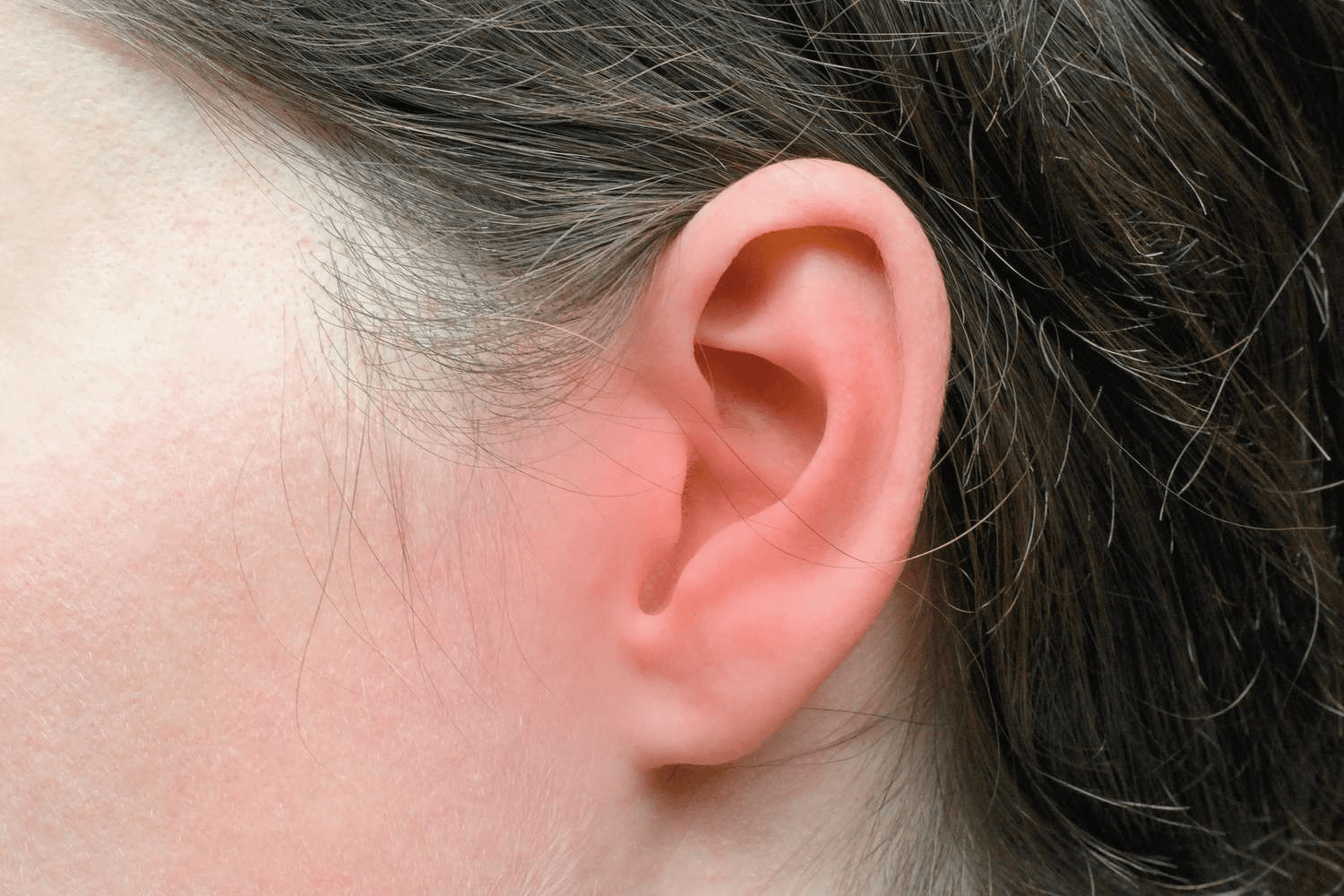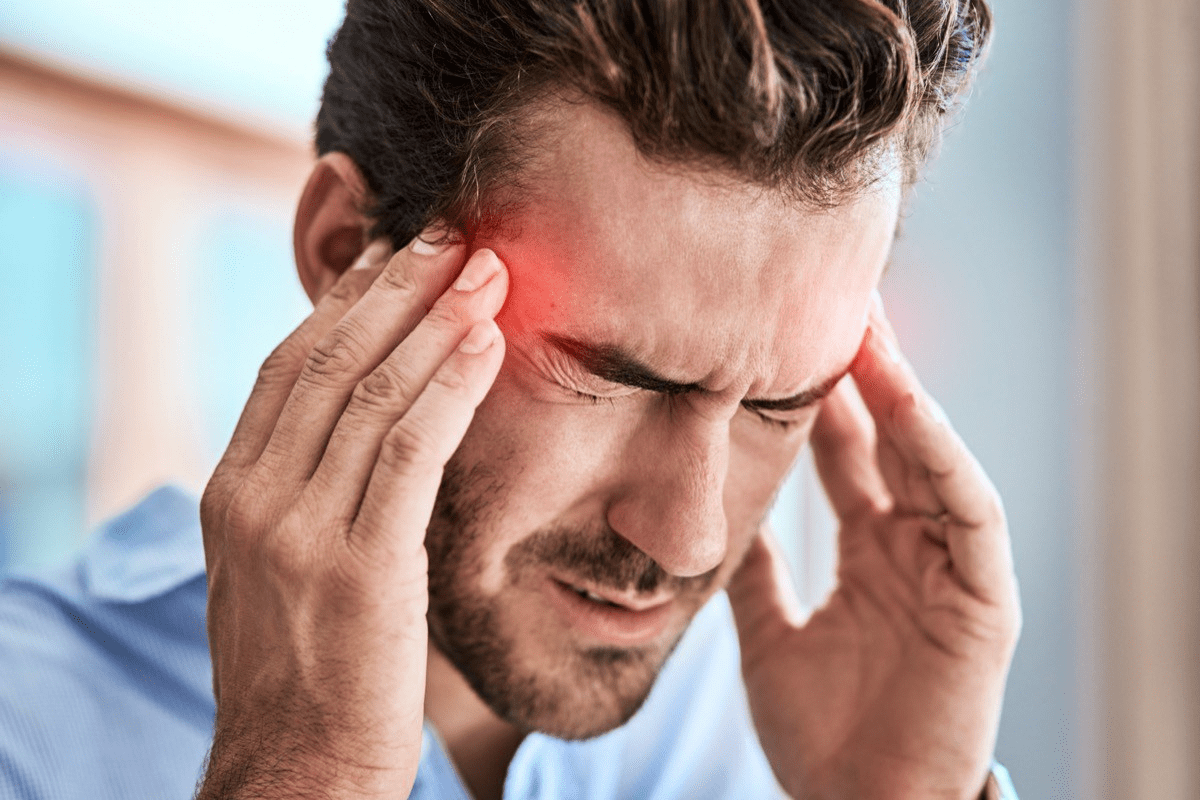
Feeling ear pain and head pain at the same time can be really tough. Many people think these symptoms are just separate issues. But knowing they’re connected is key to finding relief.
At Liv Hospital, we know that ear throbbing headache and other related problems affect a lot of people. About 75% of adults get headaches for different reasons. And earache causing head pain happens more than you might think.
We know that things like middle ear infections and migraines can make both your ears and head hurt. Our team uses a patient-focused approach. We combine trusted medical knowledge with new solutions to find out why you’re feeling this way.
Why do ear pain and head pain often occur together? Learn about referred pain and the connection to sinus and jaw issues.

Recent studies have found a surprising link between ear pain and headaches. They show how nerve pathways connect the ears and head. This connection can cause pain to be felt in both places.
The ear is a complex organ with many nerves. It gets nerve supply from the trigeminal nerve, facial nerve, and vagus nerve. This is important for understanding how pain can move between the ear and head.
Pain from the ear and head can travel through the same pathways. This leads to referred pain. The trigeminal nerve, for example, covers areas around the ear and head. It plays a big role in sending pain signals.
Some key points to consider:
Recent research shows that 71% of patients with unexplained ear pain meet the criteria for migraine disorder. This highlights the strong connection between ear pain and migraines. Knowing this is key for diagnosing and treating effectively.

Studies show a strong link between ear pain and headaches. These issues are common, affecting many adults around the world.
Headaches are a big problem, with about 75% of adults dealing with them. This shows headaches are more than just a minor issue. They can really affect our daily lives.
Research found that most unexplained ear pain is tied to migraines. About 71% of cases without a clear cause are linked to migraines. This shows how ear pain and brain issues are connected.
Also, a lot of people with headaches feel sharp ear pain. Up to 40% of them say their ear pain is sharp and quick. This shows how complex the causes of both headache and ear pain can be.
Knowing these stats is key for doctors to help. By understanding how ear pain and headaches are linked, doctors can give better care to those suffering.
Middle ear infections can cause both ear pain and headaches. These infections, known as otitis media, happen when the middle ear gets inflamed. This is usually due to a viral or bacterial infection.
Both viruses and bacteria can cause middle ear infections. Viral infections are often linked to colds and flu. Bacterial infections are more serious and can be caused by Streptococcus pneumoniae.
It’s important to know the difference between viral and bacterial infections. Viral infections might get better on their own. But bacterial infections need antibiotics.
When a middle ear infection happens, it causes inflammation and fluid buildup. This fluid pressure can hurt the eardrum and nearby areas, leading to ear pain.
The inflammation also makes the ear feel full or pressurized. This feeling can spread to the head, causing a headache. The pain can really interfere with daily life.
The Eustachian tube helps keep air pressure in the middle ear balanced. But when a middle ear infection strikes, the tube can get blocked.
This blockage can cause both ear pain and headaches. The pressure imbalance can make the eardrum bulge or retract. This leads to pain in the ear and head.
Understanding how middle ear infections block the Eustachian tube helps us see why ear pain and headaches are linked. This knowledge is key to finding effective treatments for both the infection and the pain.
The TMJ and its surroundings have a complex relationship. This can cause pain in the ear and head when the joint is not working right. TMJ disorders affect the joint and muscles that help us move our jaw.
TMJ disorders are a big problem for many, causing pain that can be mild or severe. The link between TMJ issues and ear/head pain is complex. It involves many neurological pathways.
TMJ disorders are more common than you might think. They affect about 10-15% of American adults. This shows how important it is to know about TMJ disorders and their health effects.
The symptoms of TMJ disorders can be different for everyone. This makes it hard to diagnose and treat. We will look at how TMJ disorders can cause ear and head pain.
The TMJ is near the ear, and their nerves can overlap. This can cause pain to be felt in the wrong place. The trigeminal nerve plays a big role in this. It sends pain signals from the TMJ to the brain, which can feel like ear or head pain.
This connection is why people with TMJ disorders often feel ear fullness or pain, and headaches. Knowing about this connection is key for proper diagnosis and treatment.
It can be hard to tell if pain is from TMJ disorders or something else. But, some signs can point to TMJ pain. For example, pain that gets worse when you move your jaw, or if your jaw clicks or locks.
We stress the need for a full check-up to find the cause of ear and head pain. By knowing the signs of TMJ-related pain, doctors can create better treatment plans. This helps to fix the real cause of the pain.
Migraine-associated otalgia is when people feel ear pain during migraines. It shows how our brain and ear systems work together. We’ll look into why migraines cause ear pain and how to spot the signs.
Migraines are more than just headaches. They are a brain condition that affects many parts. Scientists think it’s caused by brain activity problems, nerve signals, and blood vessel changes.
Key factors in migraine development include:
Migraines and ear pain are linked through shared nerves. During a migraine, the trigeminal nerve is active. This releases chemicals that cause pain, which can be felt in the ear.
The trigeminal nerve is key in sending pain signals. When it’s activated, pain can spread to other areas, like the ear. This is because of how nerves are connected in our face and head.
It’s important to know the signs of ear pain linked to migraines. Common symptoms include:
Knowing these symptoms helps doctors diagnose and treat migraine-related ear pain. By treating the migraine, both headache and ear pain can be reduced.
Sinus infections can cause ear discomfort and headache. The sinuses are complex cavities around the nasal passages. Their inflammation can affect many areas.
Sinus pressure can harm ear function. This is because of the Eustachian tube’s role in air pressure. Inflamed sinuses can lead to Eustachian tube dysfunction.
This dysfunction causes a feeling of plugged ears or discomfort. The Eustachian tube connects the middle ear to the back of the nose and throat. It helps balance air pressure in the ears.
Symptom | Description | Relation to Sinus Infection |
Ear Fullness | Feeling of pressure or fullness in the ears | Eustachian tube dysfunction due to sinus pressure |
Headache | Pain or pressure around the forehead, cheeks, or eyes | Direct result of sinus inflammation and pressure |
Ear Pain | Sharp or dull pain in the ears | Referred pain from sinus pressure or Eustachian tube dysfunction |
Sinus infections can spread inflammation to the ears and head. This inflammation causes pain and discomfort. The face and head have complex innervation.
An expert notes, “The sinuses are close to important structures like the eyes, ears, and brain. This makes sinusitis a serious condition that needs quick treatment.”
This highlights the importance of understanding the dual impact of sinus infections.
It’s hard to tell if pain is from sinus infections or other causes. But, some signs can help identify sinus-related pain.
Knowing these symptoms can help diagnose ear and head pain. If symptoms last or are severe, see a healthcare professional for diagnosis and treatment.
Ear pain and headache can signal many health issues. We’ve talked about common causes like middle ear infections and TMJ disorders. But, there are other serious conditions that can also cause these symptoms.
Trigeminal neuralgia is a chronic pain condition affecting the trigeminal nerve. This nerve is widespread in the head. It can cause intense pain in the face, including the ear area, and sometimes headaches.
The pain is often triggered by simple actions like touching the face, chewing, or even a light breeze.
“Trigeminal neuralgia is characterized by sudden, severe, shock-like or stabbing pain in areas of the face, including around the ear.”
Occipital neuralgia affects the occipital nerves at the base of the skull. It can cause sharp pain on one side of the head. Sometimes, this pain is mistaken for migraines or other headaches.
People with this condition often have tender scalp and neck areas. Treatments like nerve blocks can help relieve the pain.
An acoustic neuroma is a benign tumor on the eighth cranial nerve. This nerve controls hearing and balance. Symptoms include hearing loss, tinnitus, dizziness, and sometimes ear pain or headaches.
Condition | Primary Symptoms | Common Treatments |
Trigeminal Neuralgia | Facial pain, headache | Medications, surgery |
Occipital Neuralgia | Head pain, scalp tenderness | Nerve blocks, physical therapy |
Acoustic Neuroma | Hearing loss, tinnitus, dizziness | Monitoring, surgery, radiation therapy |
Meniere’s disease affects the inner ear. It can cause vertigo, tinnitus, hearing loss, and a feeling of fullness in the ear. Sometimes, it leads to headaches.
The exact cause is unknown, but it’s linked to inner ear balance issues. Treatment includes dietary changes, medications, and sometimes surgery.
It’s important to understand these conditions for proper diagnosis and treatment. If you have persistent or severe ear pain and headaches, see a healthcare professional. They can find the cause and suggest the right treatment.
Ear pain and headache can be confusing to diagnose. It’s important to find the cause for effective treatment. This is because both ear pain and headache can be very distressing.
Diagnosing ear pain and headache is tricky. It’s hard to tell if the pain is at the source or somewhere else. For example, a headache can sometimes cause ear pain because of shared nerves.
Let’s say a patient has a migraine. They might also feel ear pain. This is because the ear and head have complex nerve connections.
Many conditions can cause ear pain and headache. This makes diagnosis harder. For instance, sinus infections, TMJ disorders, and migraines can all have similar symptoms.
We need to look closely at the patient’s symptoms and medical history. This helps us find the possible causes. Here’s a table showing some common causes of ear pain and headache:
Condition | Characteristic Symptoms |
Migraine | Severe headache, ear pain, sensitivity to light and sound |
Sinus Infection | Nasal congestion, facial pain, ear pain, headache |
TMJ Disorder | Jaw pain, clicking or locking of the jaw, ear pain, headache |
To find the cause of ear pain and headache, we use different tests. These include:
Getting a detailed medical history and physical exam is also key. By using all these steps, we can create a treatment plan that meets the patient’s needs.
Getting the right treatment for ear pain and headaches starts with finding the cause. We know that headache ear fullness and earache head pressure can mean different things. So, we tailor our approach to fit each case.
Choosing the right medicine is key when treating ear and head pain together. For infections, antibiotics are often used. For pain in ear and head on right side from migraines, special migraine meds can help.
For mild pain, over-the-counter drugs are a good start. But for more serious or ongoing pain, stronger meds like muscle relaxants or corticosteroids might be needed.
Physical therapy is important for some causes of ear and head pain. It’s great for TMJ disorders or tension headaches. Jaw exercises, manual therapy, and improving posture can help.
We also suggest relaxation methods and stress management. These are part of a full physical therapy plan to improve overall health.
Sometimes, surgery is needed to fix the root cause of pain. For example, if a middle ear infection won’t go away, surgery might be needed. This could include putting in tympanostomy tubes or fixing the eardrum.
For severe TMJ disorders, surgery like arthrocentesis or open-joint surgery might be an option. This is after other treatments have not worked.
To lessen ear pain and headaches, making lifestyle changes and managing stress is key. A good prevention plan can help reduce how often and how bad these symptoms are.
Changing your lifestyle can help prevent ear pain and headaches. Regular exercise can lower stress and boost health. Also, keeping a consistent sleep schedule is important. Irregular sleep can make headaches and ear pain worse.
Stress often leads to ear pain and headaches. Using stress management methods can help. Meditation, yoga, and deep breathing exercises are great for this.
What you eat can affect ear pain and headaches. Some foods can make symptoms worse, while others can help. It’s important to know which foods to avoid and to drink lots of water.
Changing your environment can also help. Avoid loud noises and manage pressure changes when traveling. Keeping your environment comfortable is also key.
By using these prevention strategies, you can lessen ear pain and headaches. This can greatly improve your life quality.
Ear pain and head pain can really disrupt your life. They can make everyday tasks hard and affect how you feel overall. Understanding how ear and head pain are connected can help find relief and manage symptoms.
Ear pain and head pain often happen together because of shared nerves. Issues like migraines, middle ear infections, and jaw problems can cause both. Knowing the cause is key to treating it right.
Dealing with headache ear pressure and ear throbbing headache needs a full plan. This can include special medicines, physical therapy, and changes in how you live. These steps can help lessen symptoms and make life better.
At our place, we aim to give top-notch healthcare to everyone, including international patients. We make sure to diagnose correctly and offer effective treatments. This way, we help people beat ear pain and head pain, so they can enjoy a healthier, happier life.
Ear pain and headache can come from many sources. These include middle ear infections, TMJ disorders, migraines, and sinus infections. Knowing the cause is key to treating it effectively.
Yes, ear infections can lead to both ear pain and headaches. This happens because of inflammation and fluid buildup in the ear. The pain can spread to the head, causing a headache.
TMJ disorders can cause ear pain and headaches through the trigeminal nerve. This nerve carries pain signals from the TMJ to the ear and head.
Yes, migraines can cause ear pain, known as migraine-associated otalgia. Migraines can trigger ear pain through complex neurological mechanisms.
Sinus infections can lead to sinus pressure, affecting ear function and causing pain. Inflammation can also spread to surrounding areas, including the ears.
Primary pain comes from the affected area. Referred pain is felt in a different location. Knowing the difference is key for accurate diagnosis.
Diagnosing ear pain and headache involves thorough testing. This includes medical history, physical exams, and imaging studies. These tests help find the cause.
Treatment options include medications, physical therapy, and surgery for severe cases. The right treatment depends on the cause.
Yes, making lifestyle changes can help. This includes managing stress, eating right, and adjusting your environment. These changes can reduce ear pain and headaches.
Stress management techniques like relaxation exercises, meditation, and yoga can help. They can reduce stress and lower the chance of ear pain and headaches.
Yes, changing your diet can help. Avoiding trigger foods and eating a balanced diet can ease ear pain and headaches.
Yes, making environmental changes can help. Avoiding loud noises and keeping a comfortable environment can reduce ear pain and headaches.
Morgenthaler, T. I., Kagramanov, V., Hanak, V., & Decker, P. A. (2006). Complex sleep apnea syndrome: Is it a unique clinical syndrome? Sleep, 29(9), 1203-1209. [https://academic.oup.com/sleep/article/29/9/1203/2708307]
Subscribe to our e-newsletter to stay informed about the latest innovations in the world of health and exclusive offers!
WhatsApp us